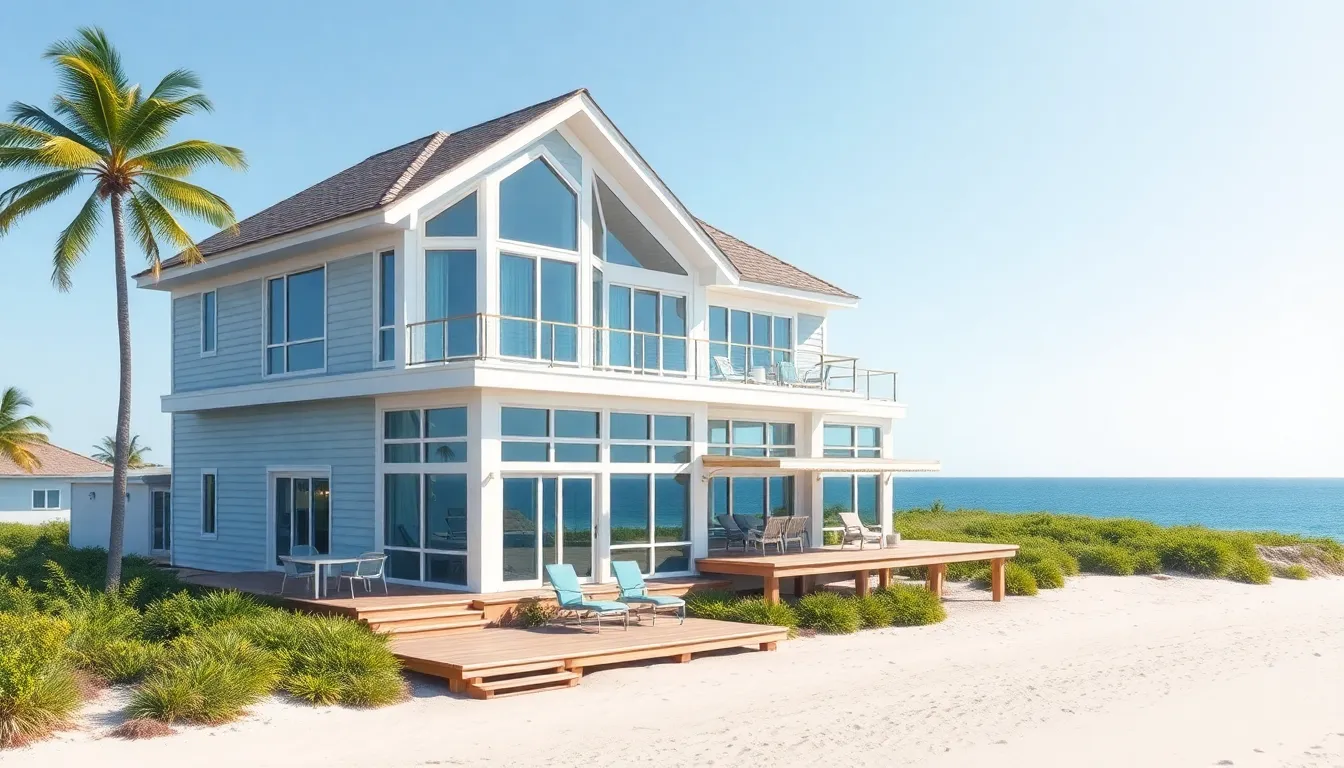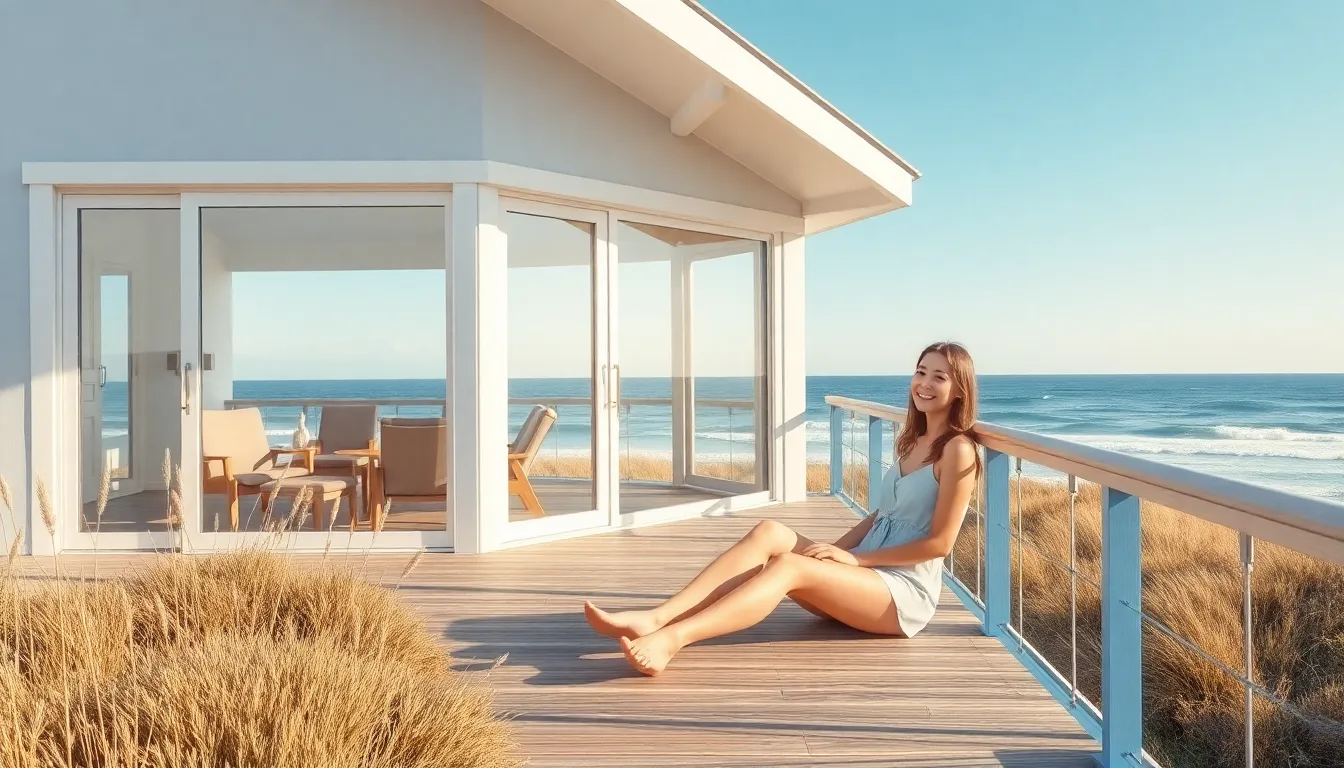Imagine waking up to the sound of waves crashing and the salty breeze gently ruffling your hair. A beach house isn’t just a home; it’s a sanctuary where relaxation meets coastal charm. Designing the perfect beach house combines functionality with a touch of whimsy, creating a space that feels as refreshing as a dip in the ocean.
Table of Contents
ToggleOverview of Beach House Design
Beach house design reflects the essence of coastal living, bringing together comfort and aesthetic appeal. Elements such as large windows invite natural light, creating an open and airy atmosphere. Architectural features like decks and patios extend living spaces outdoors, allowing residents to embrace the ocean views.
Materials often include weather-resistant options suited for coastal environments. That includes wood, metal, and glass, which enhance durability while maintaining beauty. Coastal colors, such as soft blues and sandy beiges, evoke a serene ambiance and connect the interior to the exterior landscape.
Floor plans usually prioritize open concepts, catering to both relaxation and social engagements. Spaces often flow seamlessly, promoting a laid-back lifestyle. Bedrooms tend to incorporate sliding doors, providing easy access to private outdoor spaces.
Landscaping plays a vital role in beach house design. Native plants require less maintenance and enhance the natural beauty of the surroundings. Hardscapes and walkways often blend with the environment, ensuring a cohesive look.
Sustainability often influences contemporary beach house designs. Energy-efficient systems and solar panels help reduce environmental impact while enhancing overall comfort. Incorporating green roofs or rainwater collection systems further underscores a commitment to eco-friendly living.
Style can vary, with some beach houses embracing traditional charm while others adopt a modern minimalist approach. Each design choice contributes to the unique personality of the residence, ensuring it stands as a true sanctuary by the sea.
Key Elements of Beach House Design

Designing a beach house involves specific elements that enhance relaxation and embrace coastal lifestyles. Consideration of location, architectural styles, and materials plays a significant role in achieving the desired ambiance.
Location Considerations
Location shapes the overall design and experience of a beach house. Proximity to the ocean influences natural light, views, and breezes. Elevated positions serve to protect against flooding and provide panoramic scenery. Accessibility to local amenities, like restaurants and shops, contributes to the convenience and enjoyment of coastal living. Orientation of the house ensures optimal exposure to sunlight while minimizing harsh winds.
Architectural Styles
Architectural styles give character and reflect individual preferences in beach house design. Coastal cottage styles often feature gabled roofs and porches. Modern designs typically showcase clean lines and expansive windows. Traditional New England style offers a classic charm with features like clapboard siding. Mid-century modern brings a blend of simplicity and functionality, often using open floor plans for social gathering areas. Each style contributes uniquely to the coastal aesthetic.
Materials and Finishes
Materials and finishes determine durability and aesthetic appeal in beach house construction. Weather-resistant wood, metal, and glass offer longevity while withstanding coastal elements. Finishes should include non-slip surfaces for outdoor areas and moisture-resistant paint for interiors. Colors typically reflect the natural landscape; soft blues, sandy beiges, and crisp whites create harmonious environments. Energy-efficient windows not only enhance views but also improve insulation, contributing to eco-friendly design solutions.
Indoor Spaces in Beach House Design
Indoor spaces in beach house design emphasize openness and a relaxed atmosphere. These spaces enhance the connection to the coastal environment.
Open Concept Living Areas
Open concept living areas prioritize spaciousness and fluidity. Large, unobstructed layouts create seamless transitions between living, dining, and kitchen spaces. Natural light floods these areas through expansive windows, inviting the outdoor scenery inside. Comfortable seating arrangements encourage social interactions, making them ideal for gatherings. Access to outdoor decks strengthens the relationship with nature, allowing residents to enjoy ocean breezes and views. Energy-efficient solutions enhance functionality while promoting sustainability in the design.
Coastal-Inspired Decor
Coastal-inspired decor infuses beach houses with serenity and charm. Soft colors dominate the palette, utilizing shades like ocean blues, sandy beiges, and crisp whites. Textures play a critical role, with natural materials like jute, linen, and driftwood enhancing the relaxed atmosphere. Artwork showcasing coastal landscapes adds character and reflects the surrounding environment. Accessorizing with seashells, nautical motifs, and glass accents further captures the essence of coastal living. Plants such as succulents and palm varieties contribute to a fresh and inviting ambiance.
Outdoor Spaces in Beach House Design
Outdoor spaces in beach house design enhance the coastal experience. They seamlessly blend relaxation with nature.
Decks and Patios
Decks and patios play vital roles in beach house design. These areas provide ample room for entertaining and enjoying ocean views. Materials like composite decking offer durability against harsh coastal conditions. Furthermore, comfortable furniture invites relaxation, creating ideal spaces for gatherings or sunbathing. Building elevated decks ensures unobstructed vistas, and incorporating features like fire pits or outdoor kitchens adds functionality. Notably, shade structures enhance usability, allowing enjoyment even during the hottest hours. These outdoor elements contribute significantly to creating a vibrant, welcoming atmosphere.
Landscaping for Coastal Homes
Landscaping for coastal homes emphasizes native plants and low-maintenance designs. Selecting drought-tolerant vegetation reduces water usage while ensuring lush aesthetics. Additionally, incorporating hardscaping elements, like stone pathways or patios, offers durability and charm. Choosing the right trees can provide shade and privacy, enhancing outdoor enjoyment. Designers often recommend using local materials to create harmony with the landscape. Surrounding the beach house with strategically placed plants can also reduce erosion and support local wildlife. Ultimately, thoughtful landscaping enhances beauty while connecting the home to its coastal surroundings.
Sustainable Practices in Beach House Design
Sustainable practices play a crucial role in beach house design, ensuring the preservation of coastal environments. Energy-efficient systems reduce utility costs while minimizing environmental impact. Homeowners increasingly choose solar panels to harness renewable energy, contributing to a sustainable lifestyle.
Natural ventilation is another key element, allowing fresh ocean breezes to circulate throughout the home. Choosing materials with low environmental impact enhances overall sustainability. Recycled or reclaimed wood, for instance, provides durability and aesthetic value while reducing waste.
Water conservation measures, including rainwater harvesting systems, support responsible resource management. Landscaping with native plants not only requires less water but also fosters local biodiversity. Utilizing permeable materials for driveways and paths helps manage stormwater runoff, protecting the surrounding ecosystem.
Green roofs offer additional insulation while creating habitats for local wildlife. These living spaces capture rainwater, reduce heat absorption, and improve air quality. Incorporating sustainable building practices contributes to energy efficiency and enhances the home’s connection to nature.
Locating the beach house strategically also maximizes natural advantages. Elevating homes protects against flooding and storm damage, contributing to long-term sustainability. Orientation toward prevailing winds optimizes cooling and reduces reliance on air conditioning systems.
Collaborating with architects and designers experienced in eco-friendly practices ensures that beach houses meet sustainable standards. Prioritizing sustainability not only enhances the coastal living experience but also preserves the environment for future generations. By incorporating these elements, beach houses can seamlessly blend luxury with responsible environmental stewardship.
Designing a beach house is about creating a harmonious blend of comfort and coastal charm. By prioritizing open spaces and incorporating natural elements, homeowners can foster a serene atmosphere that encourages relaxation and connection with the ocean.
Sustainable practices play a crucial role in modern beach house design. Utilizing eco-friendly materials and energy-efficient systems not only benefits the environment but enhances the overall living experience.
Ultimately, a well-designed beach house serves as a sanctuary that reflects individual style while embracing the beauty of its coastal surroundings. With careful consideration of layout, materials, and landscaping, these homes can truly embody the essence of seaside living.






